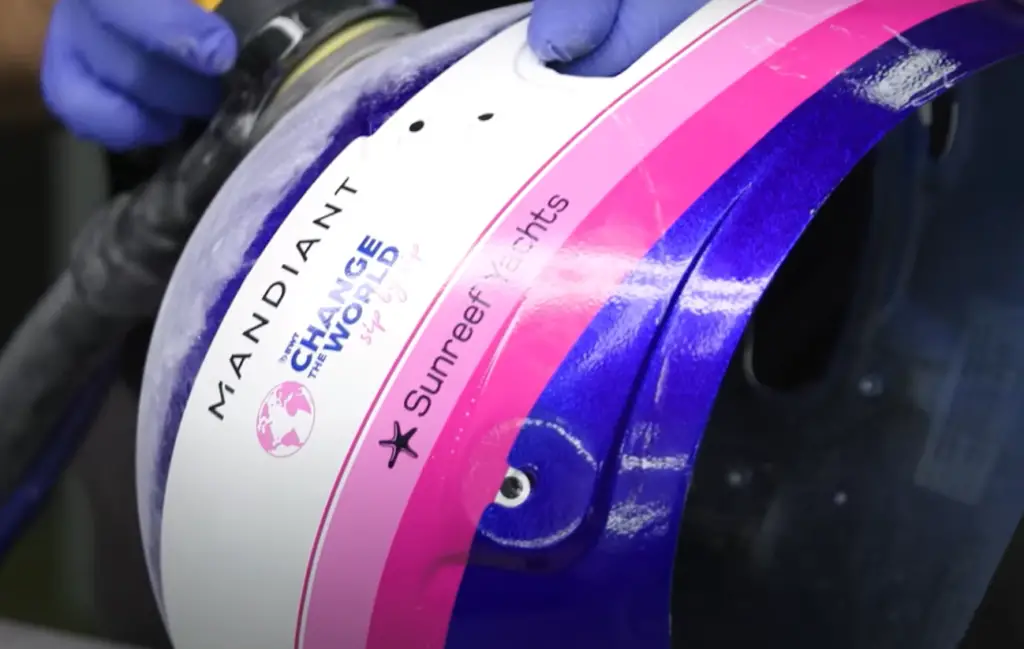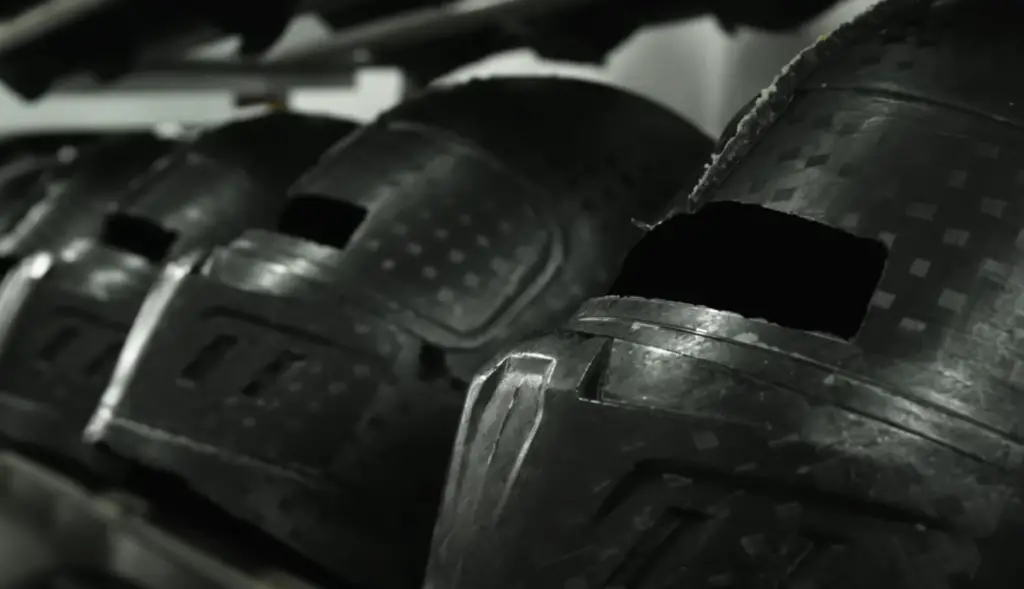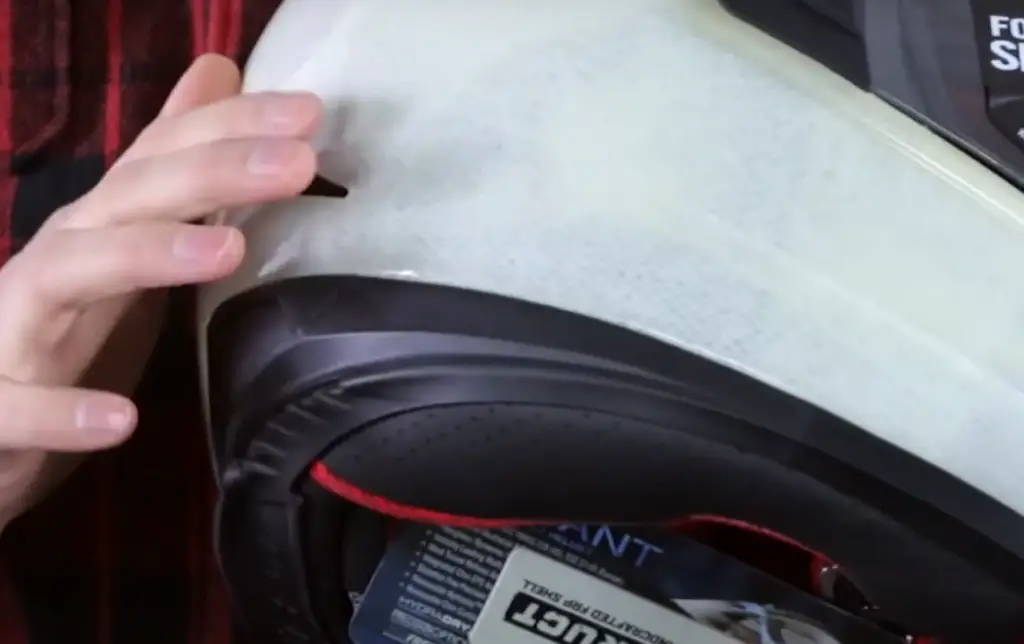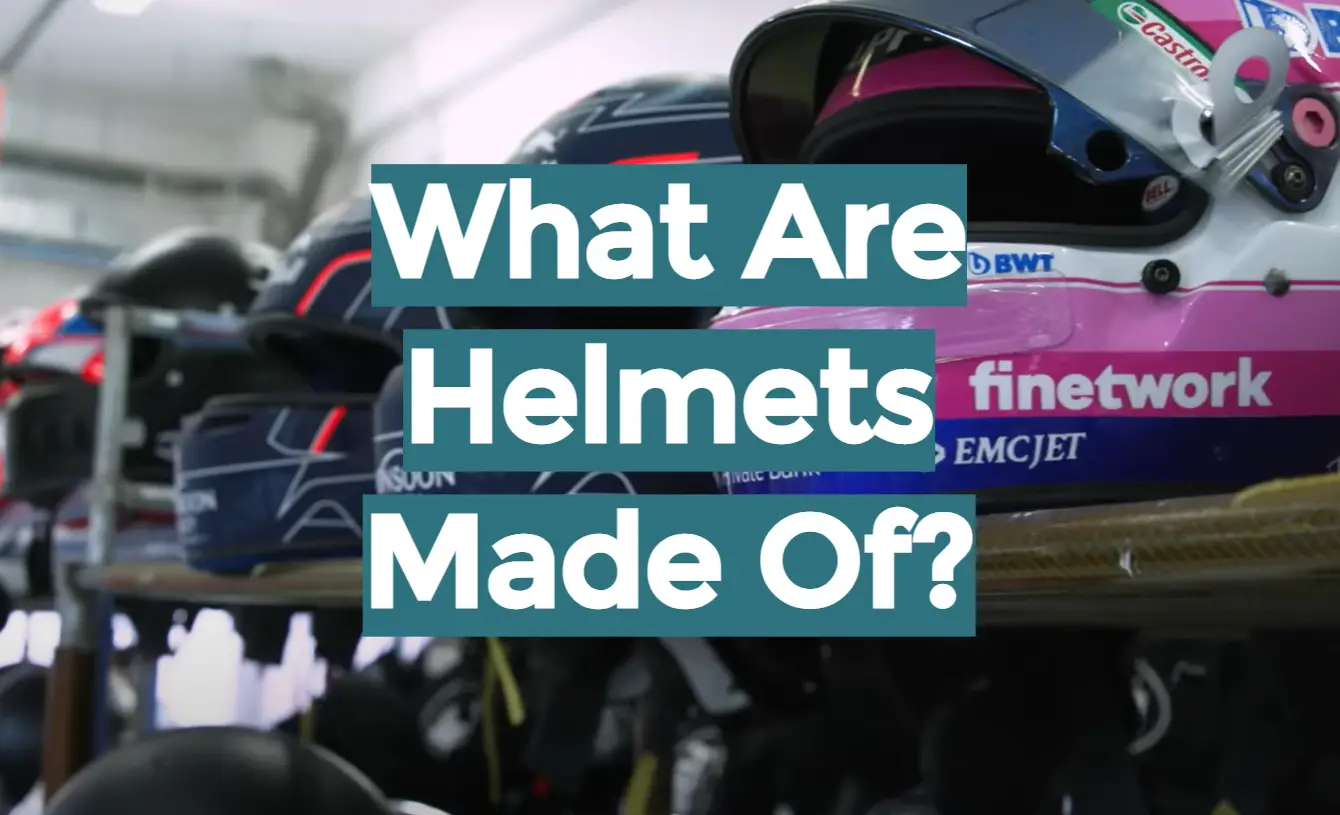There are many important factors to consider when purchasing a helmet, but one of the most important is undoubtedly what the helmet is made of. Different materials offer different levels of protection, and it’s important to understand the difference between them before making your purchase. In this article, we will break down the materials that helmets are commonly made of and discuss the pros and cons of each. We’ll also answer some common questions about helmets so that you can be sure you’re making an informed decision when you buy your next one!
Table of Contents
How helmets are made
The primary purpose of a motorcycle helmet is to protect the rider’s head from injury in crashes and falls, while the kinetic energy of the impact must be properly distributed and out of reach of the human head. Motorcycle helmets are made from a variety of materials, some helmets are made by mixing several different components.

Many manufacturers of motorcycle helmets patent their designs and do not fully disclose what materials the helmet is made of. This is due to the fact that there are many materials with different protective properties from each other.
These materials are used to make various types of motorcycle helmets, as emergencies can occur anytime, anywhere at various speeds. A motorcycle helmet must have a rigid outer shell and an impact-absorbing inner shell that will distribute the impact energy.
Materials that are used for the manufacture of motorcycle helmets:
- Here are some of the materials commonly used to make motorcycle helmets.
Outer shell:
- Thermoplastic, polycarbonate (pressed ABS plastic)
- Fiberglass (fiberglass composite material)
- Carbon fiber (carbon)
The inner shell of the shock-absorbing layer is made mainly of expanded polystyrene, this is a foam material very similar to foam. It would be unfair to say that one motorcycle helmet is better than another. There are several pros and cons for each type of helmet.
Making a motorcycle helmet
To make a motorcycle helmet, the first step is to provide workers with all the necessary materials and components for its manufacture. It will depend on the helmet company, whether they order materials and parts from other manufacturers or manufacture them themselves. Once the company has all the parts and materials that will be used in the creation of motorcycle helmets, machines and workers will be responsible for creating future helmets with proper quality control.
The manufacturing technology of the outer shell of the helmet starts with the material, it can be polycarbonate or composite material.
The polycarbonate shell is considered more durable, although it is heavier than the composite. Polycarbonate helmets are characterized by high impact strength under strong impact loads, while composite helmets have a large margin of safety and are lighter, but less resistant to fracture.
The lightest and most durable motorcycle helmets are made of carbon fiber, because the composition includes carbon fiber and such a shell consists of several layers with the addition of special resins. The outer shell of a polycarbonate helmet is made by injection molding with a press in special molds.
Composite and carbon motorcycle helmets are made using special molds and a molding press, where the composite material is first manually laid in several layers, then it is coated with a layer of resin from the inside.
The high temperature causes a chemical reaction that firmly bonds the composite material to the resin and turns the brittle material into a strong shell. Next, you need to process the frame of the helmet, for this they use a powerful and high-precision machine with water jet cutting (in terms of its accuracy, such a machine is not inferior to a laser and does not burn a fiber eye), under high pressure (more than 350,000 pascals) the contour of the helmet is cut off, then holes are made for attaching the visor and for ventilation ducts.
Then the helmet frame is polished (manually or using machine tools) of all protrusions and irregularities, then the shell is sent for painting and dried under ultraviolet lamps. The outer part of the helmet is ready for assembly.

Polycarbonate helmet shells are molded from hot plastic also under pressure using robots and use cheaper materials without manual laying of the material, so these motorcycle helmets are cheaper.
Now it’s time for an internal protective cage or multi-layered EPS liner, which is made of expanded polystyrene, as it is light and cheap material. Material such as polystyrene gives the inside of the helmet maximum wearing comfort, takes on the contour of the wearer’s head over time, also adds protective properties to the helmet and dampens impact energy.
After that, all parts of the helmet are assembled together, the inner soft lining is inserted and the visor is put on. The helmet visor is made of polycarbonate using heat treatment, it becomes unbreakable and wear-resistant to scratches.Today’s helmets
Most modern helmets are made of multiple layers of different materials. The outer shell is usually made of a tough plastic material like polycarbonate. This material is designed to resist penetration and deflect impacts. beneath the outer shell is a layer of foam, which helps to absorb the force of an impact and protect your head from being jarred. The foam also helps to keep the helmet in place on your head in the event of an accident.
The thickness and density of the foam layer can vary, depending on the type of helmet. For example, racing helmets tend to have thinner foam so that they’re lighter weight and don’t interfere with vision as much. Mountain bike helmets often have thicker foam to provide better protection on rough terrain.
The type of foam used in a helmet can also vary. Some helmets use expanded polystyrene (EPS) foam, while others use a more expensive material called polypropylene (PP). EPS is the most common type of foam in helmets, as it’s lightweight and does a good job of absorbing impacts. However, PP is less prone to shattering on impact, so it offers better protection against penetration. It’s also more expensive, so you’ll usually find it in higher-end helmets.
No matter what type of helmet you choose, make sure it has a thick layer of foam that will help protect your head in the event of an accident.
The black gold of helmets
Carbon fiber is one of the most popular materials used in high-end helmets today. It’s incredibly strong and lightweight, making it ideal for racing and other high-speed activities. Carbon fiber helmets offer great protection against both low- and high-speed impacts. They’re also very good at resisting penetration.
The only downside to carbon fiber helmets is that they’re quite expensive. But if you can afford it, they’re definitely worth the investment.

Carbon fiber is often used in making helmets due to its longevity and characteristics. Kevlar is a durable material that is often used in motorcycle helmets. Fiberglass is a less expensive option that is still protective. Plastic is the least expensive option, but its protection level is not that high. Helmets are made with different materials depending on their intended purpose.
When it comes to safety, nothing should be compromised. Choose a quality helmet so that it will last you a long time and protect you from various traumas in case of an accident.
Motorcycle helmet materials
The protective functions of the helmet are provided by a rigid outer shell and an energy-absorbing inner insert.
Modern shells are made from a variety of materials, and not every chemist by name will understand what exactly they are talking about.
The best helmets are made of durable and lightweight polymers such as polycarbonate or composite materials. Composites consist of a core (e.g. carbon fiber) reinforced with fillers of high strength and stiffness, such as Kevlar fibers. By the way, pure carbon tends to split, so it is usually used in conjunction with various plastics. The combination of several materials gives qualitatively new properties to the final product. Composite helmets are lighter for the same size, and their strength is noticeably increased. As, however, and their price.
Professional helmets are often made with multiple layers. They are glued from dissimilar materials according to special patterns. In this way, not only the best weight is achieved, but also an optimal distribution of impact energy. An example of such a technological performance is the Shoei shell made of different materials based on fiberglass.
Foamed polystyrene is usually used as a damping liner, which also dampens the shock load. Some manufacturers (of a sports orientation) add additional wrinkling or slipping inserts to the design – with an oblique impact, they scroll inside the helmet, reducing damage. The insides of an expensive helmet are not simple.
Cheap helmets from unknown manufacturers can be made of plastic not much superior to toy plastics. Is it worth taking them and how many saved dollars is worth the head, let everyone decide for himself.
Certification systems exist to guarantee minimum security. These are the American Snell and DOT standards, as well as the European ECE.
Fiberglass
Fiberglass is a material that has been used in helmets for many years. It’s inexpensive and lightweight, making it a popular choice for budget-conscious riders. Fiberglass helmets offer good protection against low-speed impacts, but they are not as effective at higher speeds. They also tend to shatter on impact, which can cause serious injuries or even death. For these reasons, fiberglass helmets are not recommended for racing or high-speed riding. Also fiberglass helmets offer very little protection against penetration.
Penetration is one of the leading causes of serious injury or death in motorcycle accidents, so it’s important to choose a helmet that can offer good protection against it. Fiberglass helmets are not the best choice for this, as they are not as sturdy as other materials.
If you’re looking for a budget-friendly helmet, fiberglass is a good option. Just be aware of its limitations and make sure you’re not putting yourself at risk by wearing one. [1]
Kevlar
Kevlar is a durable material that is often used in motorcycle helmets. It is made from Kevlar fibers that are woven together to create a fabric. This fabric is then molded into the shape of a helmet.These helmets are very common, they are liked by customers for their durability and comfort wearing.They can be more expensive than other types of helmets. [2]
Synthetic Reinforced Shell
Synthetic reinforced shell is a type of helmet that is made from a synthetic material that has been reinforced with fiberglass or carbon fiber. This type of helmet is lighter than a traditional helmet and offers good protection against impact. Synthetic reinforced shell helmets are typically more expensive than other types of helmets.
Plastic helmets
Plastic helmets are the least expensive type of helmet but do not offer as much protection as the other materials.
Plastic helmets offer good protection against impact but are not as durable as other types of helmets.Helmets made with composite fibers are typically more expensive than those made with other materials, but they offer the best protection in the event of an accident. If you are involved in any activity where there is a risk of head injury, it is worth investing in a helmet made with one of these materials. Carbon fiber, Kevlar, and fiberglass are all composite fibers that can offer good protection in the event of an accident. Choose the material that best suits your needs and budget.

If you are on a budget, a plastic helmet is a good option. However, if you can afford it, choose a helmet made with one of the composite fibers for the best protection. [3]
Helmet Safety Check
Once the helmet is assembled and ready to use, the next step is to test the helmet for safety before it goes into production. Motorcycle helmets must meet the highest safety standards, as a person’s life will depend on it. Depending on the manufacturer, there are different ways to check the safety of a helmet, testing to various standards and strength testing. For laboratory tests, a model of a human head is placed inside the helmet.
The main test is the measurement of the damping parameters of the helmet, in this test the force at which a rider riding at a speed of 30 km / h crashes into a wall is reproduced. If a dent in a helmet shows that the helmet has absorbed the force of the impact while retaining its shape, then the helmet has done the job it was intended to do.
Some developers test motorcycle helmets in an acoustic wind tunnel, which measures the noise level and aerodynamic properties of the helmet.
The results of all tests are entered into a computer, and designers can make the required changes to the shape and structure of the helmet.How Helmet Construction And Materials Protect Your Head
In the event of an accident, how well a helmet protects your head largely depends on its construction and materials. A good helmet should be able to absorb impact and distribute force around your head to prevent serious brain injury. The shell should be strong enough to deflect any sharp objects that may come into contact with it, while the inside is lined with padding to cushion your head and absorb some of the impact.
A helmet’s hard outer shell and inner Styrofoam work together to provide a significant level of protection for your head. The helmet’s hard outer shell first absorbs the impact energy and spreads it out across a larger area, preventing it from breaking or bursting. In areas where the need for impact cushioning is greatest, the Styrofoam will collapse as the shock wave passes across the shell.
Even the most inexpensive helmets on the market today, thanks to recent advancements in design and production technologies, will give better protection than many of their predecessors could have ever dreamed of.[4]
FAQ
Are helmets soft or hard?
Helmets are made of fairly durable material on the outside, because they are designed to provide protection in the event of an attack or impact against a hard surface. This is usually a hard plastic type material, but various composite materials are also used, such as Kevlar or carbon fiber. The inside of the helmet is made of shock-absorbing materials in the form of compressed foam, so that the head is comfortably located in the helmet and has a soft lining.
Thus, helmets consist of two parts. The top part is hard, the inside is soft.
What are NFL helmets made of?
NHL helmets are made from the same materials as motorcycle helmets. It could be metal, plastic and other composite materials. The difference from motorcycle helmets is their shape and purpose. Often, hockey helmets come in the form of a metal mesh or a plastic curtain that protects the eyes from accidental contact with a puck or stick. Various additional characteristics that make sense for playing hockey can also be added.
What helmet does Tom Brady use?
Tom Brady, quarterback for the Tampa Bay Buccaneers wears a Riddell Speedflex helmet. This type of helmet is made with a synthetic material that has been reinforced with fiberglass or carbon fiber. The Riddell Speedflex helmet is lighter than a traditional helmet and offers good protection against impact.
Why are tinted visors illegal?
Tinted visors are illegal in the NFL because they can make it difficult for players to see each other on the field. Tinted visors can also make it difficult for players to see out of the helmet, which can be a safety hazard.
If you are involved in any activity where there is a risk of head injury, it is worth investing in a helmet with a clear visor so that you can see clearly and avoid injury. [5]
Useful Video: What Motorcycle Helmets are Made Of
Conclusion
Helmets are made of a variety of materials, but their primary purpose is to protect the head from injury. While there are many different types and styles of helmets available on the market, they all share one common goal: keeping your head safe in the event of an accident. Whether you’re a cyclist, skier, or just someone who wants to be prepared for the worst, wearing a helmet is always a good idea. Thanks for reading!
References:
- https://www.championhelmets.com/us/magazine/post/polycarbonate-vs-fiberglass-vs-carbon-fiber-shell-motorcycle-helmets-video-2
- https://abrams.com.ua/en/kaska-kevlarovaya-shlem-boevoj-daniya-arch-multicam-9766/
- https://www.made-in-china.com/products-search/hot-china-products/Plastic_Helmet.html
- https://theridingkid.com/difference-between-soft-shell-and-hard-shell-bike-helmet/
- https://unbate.com/article/why-are-tinted-visors-illegal






Leave a Reply